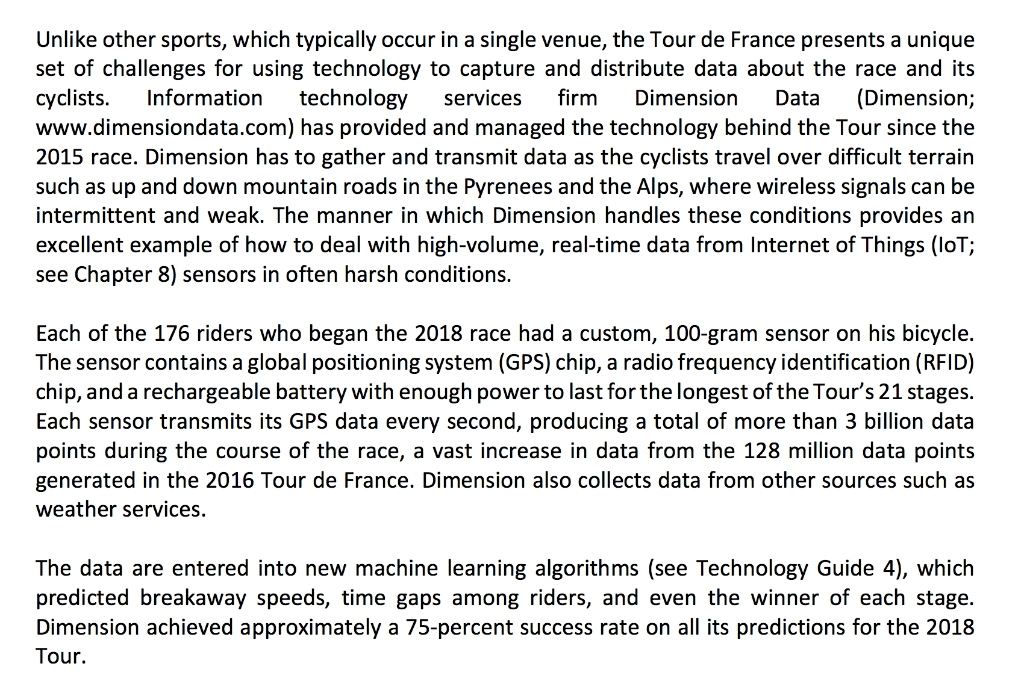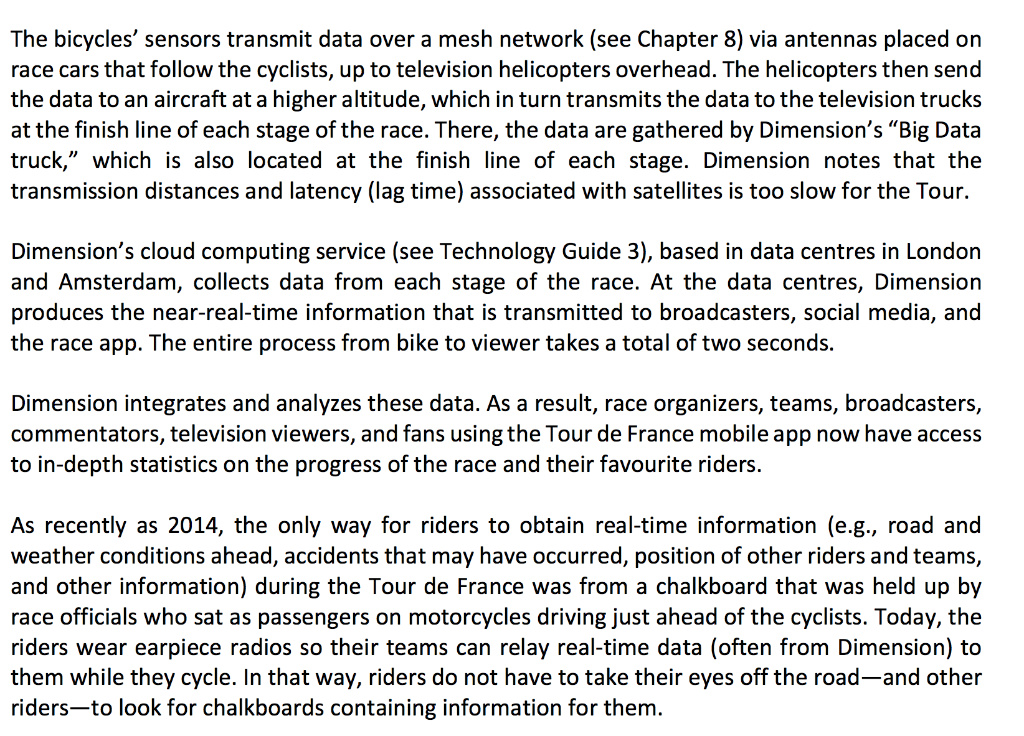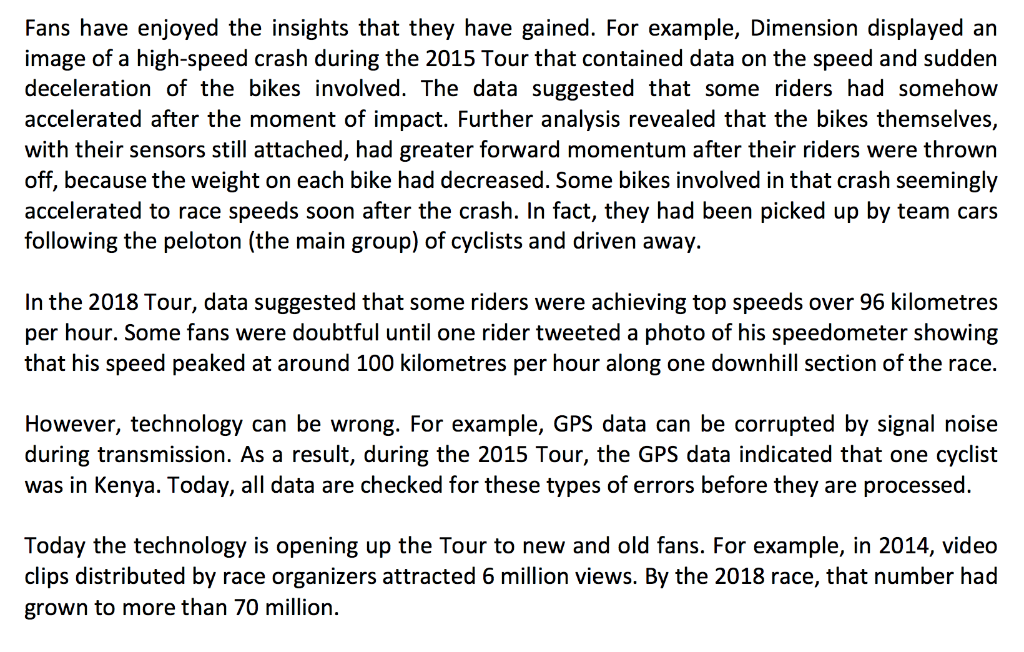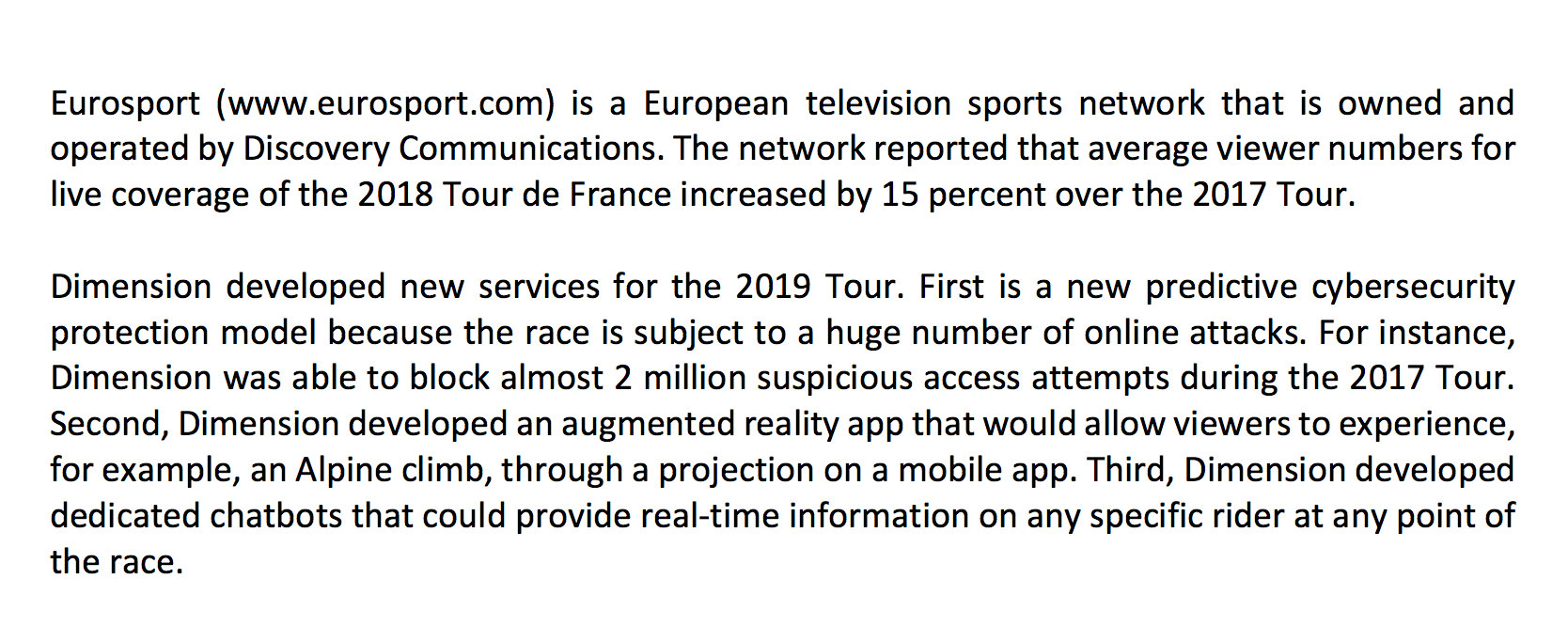Answered step by step
Verified Expert Solution
Question
1 Approved Answer
Question: Identify and Discuss 5 Data Quality Issues that would apply to Tour de France Data Enhances Fans' Experience of the Tour de France Many





Question: Identify and Discuss 5 Data Quality Issues that would apply to Tour de France
Data Enhances Fans' Experience of the Tour de France Many sports, such as football, cricket, tennis, and baseball, provide huge amounts of data to fans in addition to the video feeds themselves. These data increase their enjoyment and improve their understanding of various sporting events. Significantly, the data can become overwhelming. Some fans still prefer to simply watch sporting events. In 1903 the French sports newspaper L'Auto established the Tour de France as a marketing tool to increase sales. Although the Tour de France is world famous, it is also a challenge to watch. Television viewers can see the racers from numerous camera angles, but it is difficult to understand the subtleties and tactics of elite professional bicyclists. In addition, the race lasts for three weeks. Compounding these issues, the Tour's followers are more digitally engaged on social media than ever before, and they want a live and compelling experience during the Tour. This improved experience requires data. Today, the Tour is deploying technology to capture data and perform analytics in near real time to help engage a new generation of digital fans. The 2018 Tour de France provided more data to fans than ever before, explaining and analyzing the performance of the racers in detail for the duration of the race. Unlike other sports, which typically occur in a single venue, the Tour de France presents a unique set of challenges for using technology to capture and distribute data about the race and its cyclists. Information technology services firm Dimension Data (Dimension; www.dimensiondata.com) has provided and managed the technology behind the Tour since the 2015 race. Dimension has to gather and transmit data as the cyclists travel over difficult terrain such as up and down mountain roads in the Pyrenees and the Alps, where wireless signals can be intermittent and weak. The manner in which Dimension handles these conditions provides an excellent example of how to deal with high-volume, real-time data from Internet of Things (IoT; see Chapter 8) sensors in often harsh conditions. Each of the 176 riders who began the 2018 race had a custom, 100-gram sensor on his bicycle. The sensor contains a global positioning system (GPS) chip, a radio frequency identification (RFID) chip, and a rechargeable battery with enough power to last for the longest of the Tour's 21 stages. Each sensor transmits its GPS data every second, producing a total of more than 3 billion data points during the course of the race, a vast increase in data from the 128 million data points generated in the 2016 Tour de France. Dimension also collects data from other sources such as weather services. The data are entered into new machine learning algorithms (see Technology Guide 4), which predicted breakaway speeds, time gaps among riders, and even the winner of each stage. Dimension achieved approximately a 75-percent success rate on all its predictions for the 2018 Tour. The bicycles' sensors transmit data over a mesh network (see Chapter 8) via antennas placed on race cars that follow the cyclists, up to television helicopters overhead. The helicopters then send the data to an aircraft at a higher altitude, which in turn transmits the data to the television trucks at the finish line of each stage of the race. There, the data are gathered by Dimension's "Big Data truck, which is also located at the finish line of each stage. Dimension notes that the transmission distances and latency (lag time) associated with satellites is too slow for the Tour. Dimension's cloud computing service (see Technology Guide 3), based in data centres in London and Amsterdam, collects data from each stage of the race. At the data centres, Dimension produces the near-real-time information that is transmitted to broadcasters, social media, and the race app. The entire process from bike to viewer takes a total of two seconds. Dimension integrates and analyzes these data. As a result, race organizers, teams, broadcasters, commentators, television viewers, and fans using the Tour de France mobile app now have access to in-depth statistics on the progress of the race and their favourite riders. As recently as 2014, the only way for riders to obtain real-time information (e.g., road and weather conditions ahead, accidents that may have occurred, position of other riders and teams, and other information) during the Tour de France was from a chalkboard that was held up by race officials who sat as passengers on motorcycles driving just ahead of the cyclists. Today, the riders wear earpiece radios so their teams can relay real-time data (often from Dimension) to them while they cycle. In that way, riders do not have to take their eyes off the road-and other riders-to look for chalkboards containing information for them. Fans have enjoyed the insights that they have gained. For example, Dimension displayed an image of a high-speed crash during the 2015 Tour that contained data on the speed and sudden deceleration of the bikes involved. The data suggested that some riders had somehow accelerated after the moment of impact. Further analysis revealed that the bikes themselves, with their sensors still attached, had greater forward momentum after their riders were thrown off, because the weight on each bike had decreased. Some bikes involved in that crash seemingly accelerated to race speeds soon after the crash. In fact, they had been picked up by team cars following the peloton (the main group) of cyclists and driven away. In the 2018 Tour, data suggested that some riders were achieving top speeds over 96 kilometres per hour. Some fans were doubtful until one rider tweeted a photo of his speedometer showing that his speed peaked at around 100 kilometres per hour along one downhill section of the race. However, technology can be wrong. For example, GPS data can be corrupted by signal noise during transmission. As a result, during the 2015 Tour, the GPS data indicated that one cyclist was in Kenya. Today, all data are checked for these types of errors before they are processed. Today the technology is opening up the Tour to new and old fans. For example, in 2014, video clips distributed by race organizers attracted 6 million views. By the 2018 race, that number had grown to more than 70 million. Eurosport (www.eurosport.com) is a European television sports network that is owned and operated by Discovery Communications. The network reported that average viewer numbers for live coverage of the 2018 Tour de France increased by 15 percent over the 2017 Tour. Dimension developed new services for the 2019 Tour. First is a new predictive cybersecurity protection model because the race is subject to a huge number of online attacks. For instance, Dimension was able to block almost 2 million suspicious access attempts during the 2017 Tour. Second, Dimension developed an augmented reality app that would allow viewers to experience, for example, an Alpine climb, through a projection on a mobile app. Third, Dimension developed dedicated chatbots that could provide real-time information on any specific rider at any point of the raceStep by Step Solution
There are 3 Steps involved in it
Step: 1

Get Instant Access to Expert-Tailored Solutions
See step-by-step solutions with expert insights and AI powered tools for academic success
Step: 2

Step: 3

Ace Your Homework with AI
Get the answers you need in no time with our AI-driven, step-by-step assistance
Get Started


